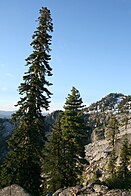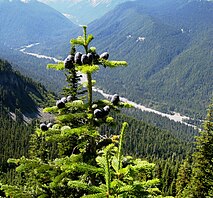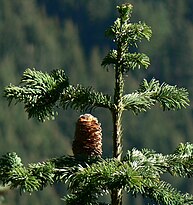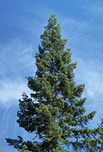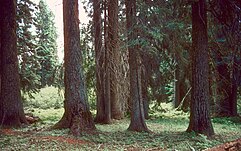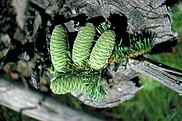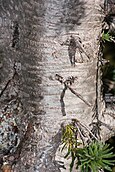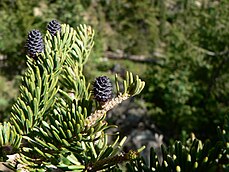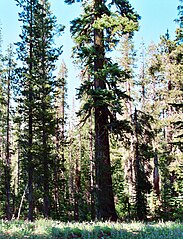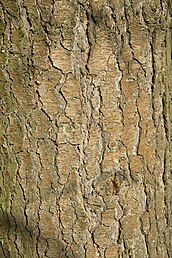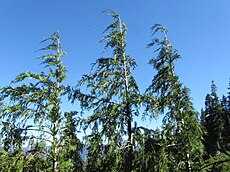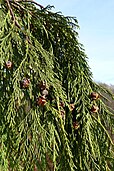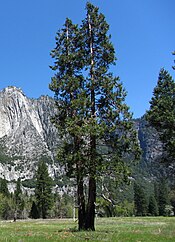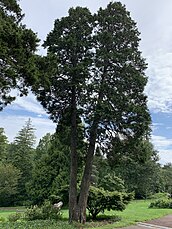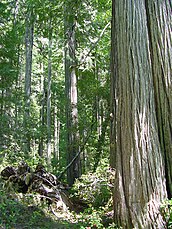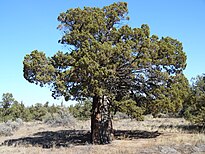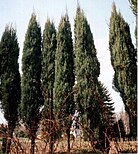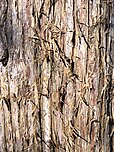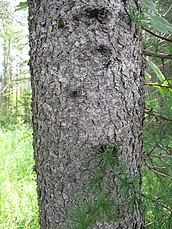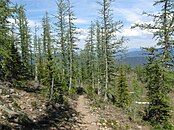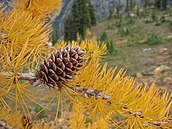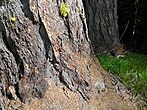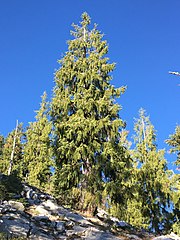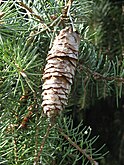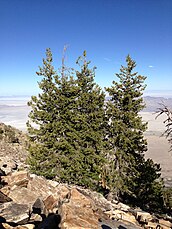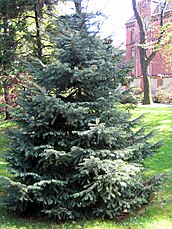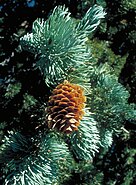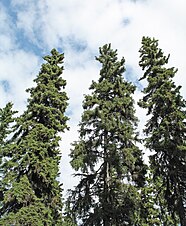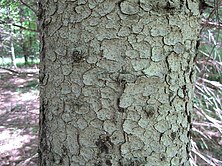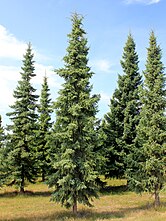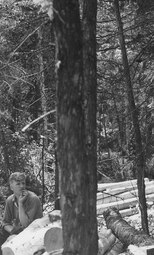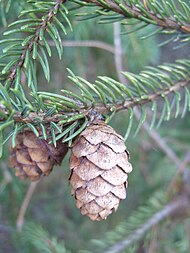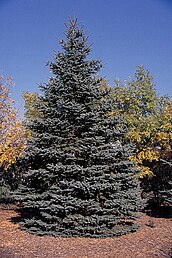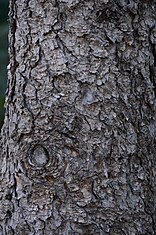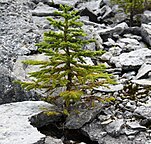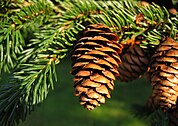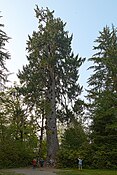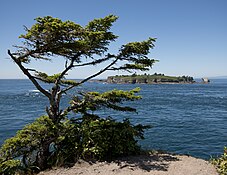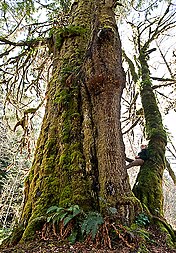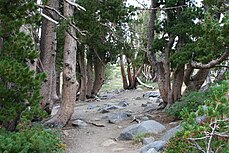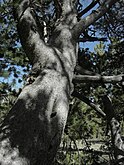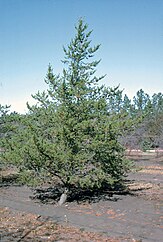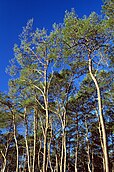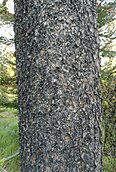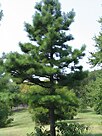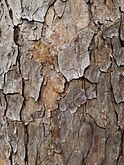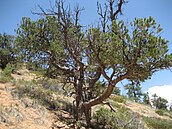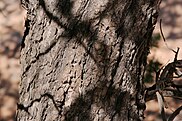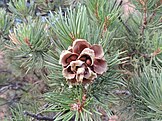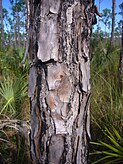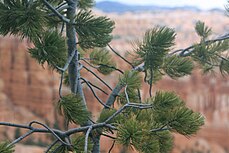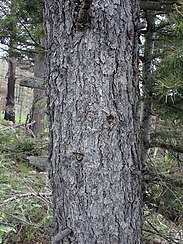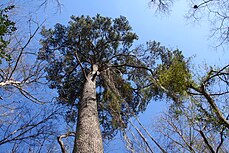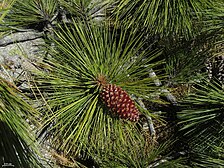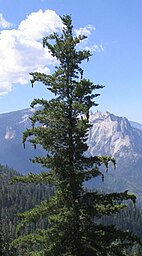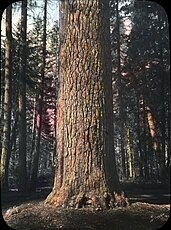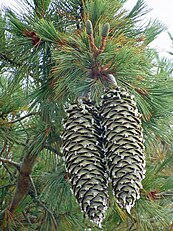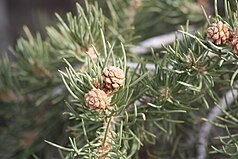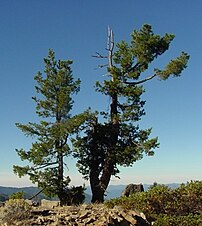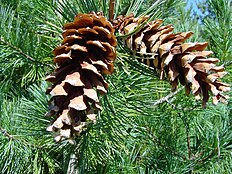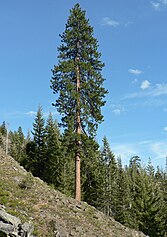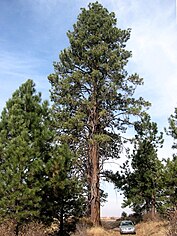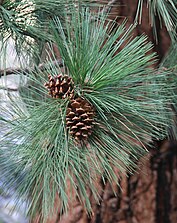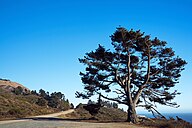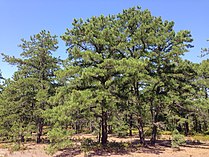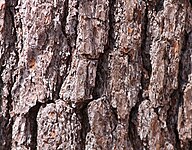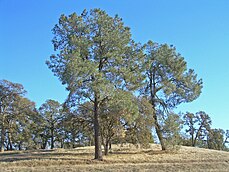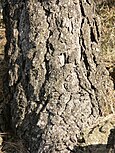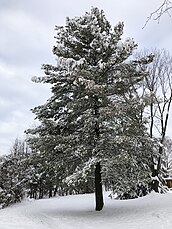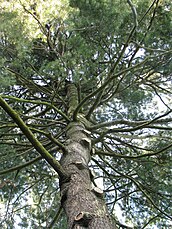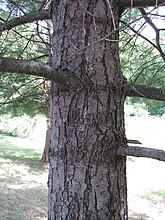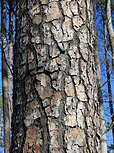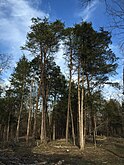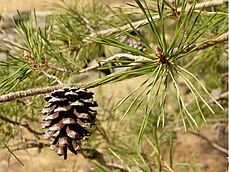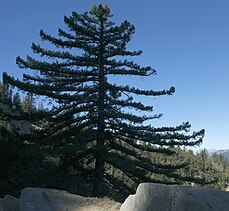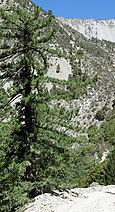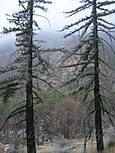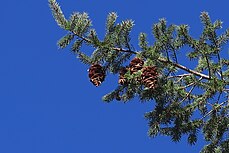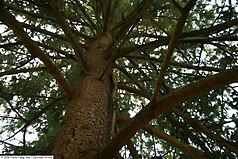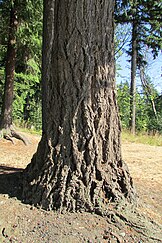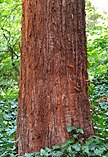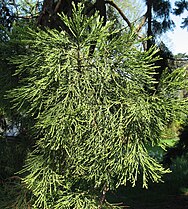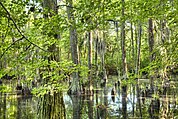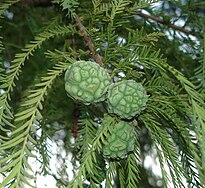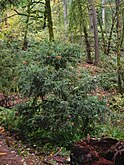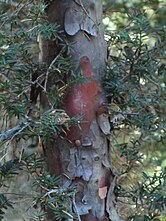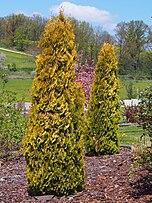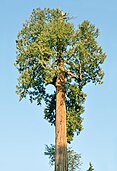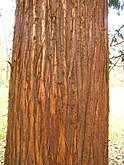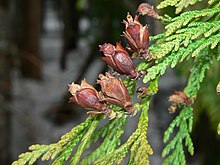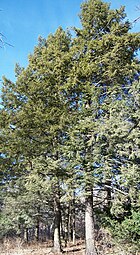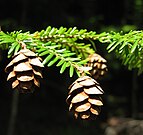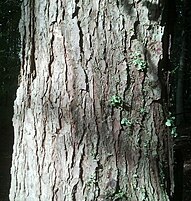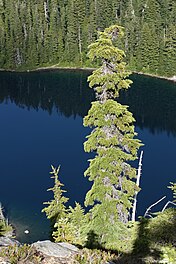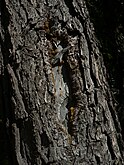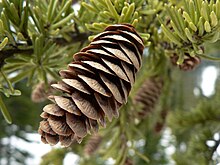List of inventoried conifers in the United States

Silvics of North America (1991),[1] a forest inventory compiled and published by the United States Forest Service, includes many conifers.[a] It superseded Silvics of Forest Trees of the United States (1965), which was the first extensive American tree inventory.[3] A variety of statistics on all of these trees are maintained by the National Plant Data Team of the US Department of Agriculture.[4]
All of the conifers in the inventory except the larches and some bald cypresses are evergreens.[5] Apart from two species in the yew family, all are in either the pine family (including firs, larches, spruces, pines, Douglas firs and hemlocks) or the cypress family (including junipers, redwoods, giant sequoias, bald cypresses and four genera of cedars).[2][6][7][b]
Softwood from North American conifers has a variety of commercial uses. The sturdier timber is milled for plywood, wood veneer and construction framing, including structural support beams and studs. Logs can be fashioned into posts, poles and railroad ties. Less sturdy timber is often ground and processed into pulpwood, principally for papermaking. Resins from sap yield wood tar, turpentine or other terpenes. Some resins and other tree products contain dangerous toxins (not generally listed below).[8]
Key
[edit]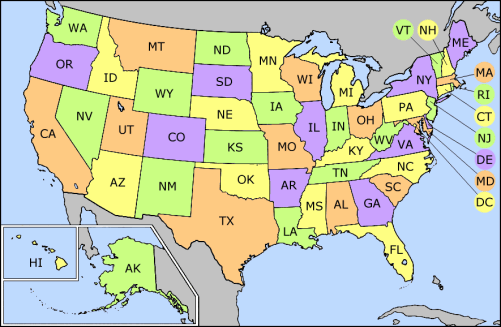
West of the Mississippi River: AK Alaska AR Arkansas AZ Arizona CA California CO Colorado IA Iowa ID Idaho KS Kansas LA Louisiana MN Minnesota MO Missouri MT Montana ND North Dakota NE Nebraska NM New Mexico NV Nevada OK Oklahoma OR Oregon SD South Dakota TX Texas UT Utah WA Washington WY Wyoming. (Hawaii is not associated with any conifer species in the 1991 inventory.)
These are often divided up into:
- The continental Western states: AK AZ CA CO ID MT NM NV OR UT WA WY
- The South Central states: AR LA OK TX
- The Midwestern states west of the Mississippi (including MN, which is mostly west or north of the river), also called the western Midwest: IA KS MN MO ND NE SD
East of the Mississippi: AL Alabama CT Connecticut DE Delaware FL Florida GA Georgia IL Illinois IN Indiana KY Kentucky MA Massachusetts MD Maryland ME Maine MI Michigan MS Mississippi NC North Carolina NH New Hampshire NJ New Jersey NY New York OH Ohio PA Pennsylvania RI Rhode Island TN Tennessee VA Virginia VT Vermont WI Wisconsin WV West Virginia
These are often divided up into:
- New England: CT MA ME NH RI VT
- The Mid-Atlantic: DE MD NJ NY PA VA WV
- The Southeast: AL FL GA KY MS NC SC TN
- The Midwestern states east of the Mississippi, also called the eastern Midwest: IL IN MI OH WI
Conifers
[edit]| Species and a common name[2][9][10] | Notes and commercial uses | Eastern distribution
western distribution[c] avg height; |
Limits for soil pH, annual precipitation and low temperature | Tolerance: (D)rought (F)ire, (L)iming and (S)hade |
Landscapes, bark and cones with foliage |
|---|---|---|---|---|---|
| Abies amabilis (Pacific silver fir) | Can reach 230 ft (70 m) in height. The timber is lightweight, with low resin content. The species can easily be distinguished from non-fir conifers by the grey, blistery trunk and rigid branches.
Uses: timber; landscaping, pulpwood, veneers, winter holiday decorations[11][12] |
—
AK CA OR WA 165 ft (50 m); slow[11] |
pH 3.3–6.0
38–260 in (97–660 cm) |
D: low F: none L: low S: tolerant [11] |
|
| Abies balsamea (balsam fir) | A significant source of food and shelter for wildlife. Horizontal blisters in the bark contain aromatic Canada balsam.
Uses: timber; landscaping, pulpwood, terpenes, veneers, winter holiday decorations[13][14] |
IN MI OH WI, New England and the Mid-Atlantic
—
60 ft (18 m); slow[13] |
pH 4.0–6.0
13–60 in (33–152 cm) |
D: low F: low L: low S: tolerant [13] |
|
| Abies concolor (white fir) | The high-grade wood is used widely for framing and plywood.
Uses: timber; landscaping, pulpwood, veneers, winter holiday decorations[15][16] |
MA ME
AZ CO ID NM NV OR UT WY 120 ft (37 m); slow[15] |
pH 5.5–7.8
18–80 in (46–203 cm) |
D: medium F: medium L: low S: medium [15] |
|
| Abies fraseri (Fraser fir) | The only fir with a range limited to the southern Appalachians. It provides watershed protection, and is grown commercially for winter holidays.
Uses: landscaping, pulpwood, veneers, winter holiday decorations[17][18] |
GA NC TN VA
—
55 ft (17 m); moderate[17] |
pH 3.5–5.5
45–100 in (110–250 cm) |
D: low F: low L: low S: tolerant [17] |
|
| Abies grandis (grand fir) | Can reach 230 ft (70 m) in height. The foliage has a distinct orange-like scent. The wood is soft, and not as durable as in other fir species.
Uses: timber; landscaping, pulpwood, veneers, winter holiday decorations[19][20] |
—
CA ID MT OR WA 150 ft (46 m); moderate[19] |
pH 4.5–7.5
11–100 in (28–254 cm) |
D: medium F: high L: low S: tolerant [19] |
|
| Abies lasiocarpa (subalpine fir) | Provides habitat for wildlife and nutrition for livestock.
Uses: timber; landscaping, pulpwood, winter holiday decorations[21][22][23] |
—
the continental Western states 90 ft (27 m); slow[22] |
pH 4.0–6.5
20–150 in (51–381 cm) |
D: low F: low L: low S: tolerant [22] |
|
| Abies magnifica (California red fir) | Prevalent near many natural water sources at high altitudes in California.
Uses: timber; landscaping, pulpwood, veneers, winter holiday decorations[24][25] |
NY
CA NV OR 150 ft (46 m); slow[24] |
pH 5.0–6.1
33–64 in (84–163 cm) |
D: low F: low L: low S: tolerant [24] |
|
| Abies procera (noble fir) | Limited to the Cascade Range and coastal mountain ranges west of that range. It is the largest fir. The wood is stronger (and generally more expensive) than in other firs.
Uses: timber; landscaping, pulpwood, veneers, winter holiday decorations[26][27] |
—
CA OR WA 230 ft (70 m); rapid[26] |
pH 6.0–7.5
64–120 in (160–300 cm) |
D: low F: low L: low S: medium [26] |
|
| Callitropsis nootkatensis (Alaska cedar)[28] | Formerly a significant timber tree providing durable, multi-use wood. Most of the trees have already been cleared, aside from limited numbers in protected areas. It is listed as Chamaecyparis nootkatensis in the 1991 inventory. | —
AK CA OR WA 75 ft (23 m); slow[29] |
pH 5.5–7.0
45–100 in (110–250 cm) |
D: low F: low L: none S: tolerant [29] |
|
| Calocedrus decurrens (incense cedar) | Known as Libocedrus decurrens in the 1991 inventory. The heartwood is often used for siding. | —
CA NV OR 100 ft (30 m); slow[31] |
pH 4.6–7.1
20–80 in (51–203 cm) |
D: medium F: low L: low S: medium [31] |
|
| Chamaecyparis lawsoniana (Port Orford cedar) | Susceptible to root rot. The logs are frequently exported to Japan. As an ornamental tree, it has more than 200 known cultivars. | —
CA OR 200 ft (61 m); moderate[33] |
pH 4.2–7.5
49–110 in (120–280 cm) |
D: low F: medium L: medium S: tolerant [33] |
|
| Chamaecyparis thyoides (Atlantic white cedar) | Usually found in swamps and marshes. The decay-resistant wood retains commercial value in the Southeast, although harvesting has considerably reduced its acreage. | AL MS and every state on the Atlantic coast
—
50 ft (15 m); moderate[35] |
pH 3.5–6.3
40–70 in (100–180 cm) |
D: none F: medium L: none S: medium [35] |
|
| Juniperus occidentalis (western juniper) | Used locally since the 19th century for durable poles and as firewood, and now also for furniture, toys and paneling. | —
CA ID NV OR WA 33 ft (10 m); slow[36] |
pH 6.0–8.5
8–24 in (20–61 cm) |
D: high F: low L: high S: intolerant [36] |
|
| Juniperus scopulorum (Rocky Mountain juniper) | Usually a shrub or small tree. The wood is durable, especially when seasoned, and suitable for furniture. The resins are aromatic. | —
All continental states west of the Mississippi, except for AK, CA and the five states just west of the river (AR IA LA MN MO) 50 ft (15 m); slow[38] |
pH 5.0–8.5
9–26 in (23–66 cm) |
D: high F: low L: high S: intolerant [38] |
|
| Juniperus virginiana (eastern red cedar) | An important support species for wildlife throughout its range. Although the tree has limited commercial use, the wood is highly valued for its appearance and robustness. The resins are aromatic. J. silicicola is also listed in the 1991 inventory, but this is now a synonym of a variety of J. virginiana.
Uses: landscaping, posts, veneers, winter holiday decorations[40][41] |
All states east of the Mississippi
CO KS ND NE OK OR SD TX and the five states just west of the river (AR IA LA MN MO) 50 ft (15 m); slow[40] |
pH 4.7–8.0
15–68 in (38–173 cm) |
D: high F: low L: high S: medium [40] |
|
| Larix laricina (tamarack) | Adapted to a variety of poor soil conditions, including peatland. The tree has one of the widest distributions among North American conifers. | The eastern Midwest, New England and the Mid-Atlantic
AK MN 80 ft (24 m); rapid[42] |
pH 5.5–6.5
7–55 in (18–140 cm) |
D: low F: none L: low S: intolerant [42] |
|
| Larix lyallii (subalpine larch) | Distinguishable from western larch by its woolly buds and new growth. In its range, the subalpine larch is often found growing higher on cold mountain slopes than other trees. | —
ID MT WA 40 ft (12 m); slow[44] |
pH 3.9–5.6
26–95 in (66–241 cm) |
D: high F: low L: none S: intolerant [44] |
|
| Larix occidentalis (western larch) | The largest larch, and the most important one commercially for its timber. Also a significant source of arabinogalactan, a gum used as a thickening agent. | —
ID MT OR UT WA WY 200 ft (61 m); rapid[46] |
pH 6.0–7.0
13–50 in (33–127 cm) |
D: low F: low L: low S: intolerant [46] |
|
| Picea breweriana (Brewer spruce) | Also called "weeping spruce", for the fringe-like branchlets that hang from the horizontal branches. It is a popular tree for landscaping in Europe. | —
CA OR 100 ft (30 m); slow[48] |
pH 4.6–7.5
21–110 in (53–279 cm) |
D: low F: low L: none S: tolerant [48] |
|
| Picea engelmannii (Engelmann spruce) | Typically contains many small wood knots that lower the grade of the timber. The light colour, long fibres and very low resin content contribute to the quality of its pulpwood.
Uses: timber; landscaping, posts, pulpwood, terpenes, veneers[50][51] |
—
the continental Western states 120 ft (37 m); slow[50] |
pH 6.0–8.0
21–160 in (53–406 cm) |
D: low F: low L: high S: tolerant [50] |
|
| Picea glauca[d] (white spruce) | Used to build furniture, pallets and musical instruments. | MD MI NJ NY PA WI and New England
AK ID MN MT SD WY 100 ft (30 m); slow[52] |
pH 4.0–8.2
7–50 in (18–127 cm) |
D: high F: low L: low S: medium [52] |
|
| Picea mariana (black spruce) |
Mainly harvested for pulpwood; construction uses are limited by the small size (for a spruce). The pale yellow wood is lightweight but strong. Uses: timber; landscaping, pulpwood, terpenes, winter holiday decorations[55][56] |
IL MI NJ NY PA WI and New England
AK MN 65 ft (20 m); slow[55] |
pH 4.7–6.5
5–60 in (13–152 cm) |
D: low F: none L: low S: tolerant [55] |
|
| Picea pungens (blue spruce) | The brittle wood has little economic value, but the tree's symmetry and unusual color make it a popular ornamental tree with at least 38 cultivars. | MD ME NY PA
AZ CO ID MN NM UT WY 100 ft (30 m); slow[57] |
pH 5.5–7.8
20–45 in (51–114 cm) |
D: medium F: low L: high S: medium [57] |
|
| Picea rubens (red spruce) | The straight-grained wood is lightweight but strong. It is the most popular choice in many stringed instruments for its resonance. | NC TN, the Mid-Atlantic and New England
—
110 ft (34 m); moderate[59] |
pH 4.0–5.8
28–52 in (71–132 cm) |
D: medium F: none L: low S: tolerant [59] |
|
| Picea sitchensis (Sitka spruce) | The largest spruce. The strong wood is used in light aircraft, masts and turbine blades. It is also used in many musical instruments for its resonance. | —
AK CA OR WA 200 ft (61 m); moderate[61] |
pH 3.9–5.7
22–225 in (56–572 cm) |
D: low F: none L: medium S: tolerant [61] |
|
| Pinus albicaulis (whitebark pine) | A slow-growing and long-lived pioneer species that helps reduce the movement of soil and snow. The seeds are a source of nutrition for birds, small mammals, black bears and grizzly bears. | —
CA ID MT NV OR WA WY 65 ft (20 m); slow[63] |
pH 4.8–8.0
18–72 in (46–183 cm) |
D: high F: none L: low S: medium [63] |
|
| Pinus banksiana (jack pine) | Sometimes milled for utility poles and railroad ties.
Uses: timber; landscaping, posts, pulpwood, terpenes[65][66] |
NY PA WV, the eastern Midwest and New England
MN MO ND 80 ft (24 m); rapid[65] |
pH 6.0–8.2
15–35 in (38–89 cm) |
D: low F: none L: low S: intolerant [65] |
|
| Pinus clausa (sand pine) | Grown on plantations for biofuel. | AL FL GA MS NC
TX 80 ft (24 m); slow[67] |
pH 4.2–5.5
40–65 in (100–170 cm) |
D: low F: low L: none S: medium [67] |
|
| Pinus contorta (lodgepole pine) | Used in paneling, and sometimes milled for utility poles and railroad ties. The trees usually grow rapidly when young and can be harvested economically. | —
SD and the continental Western states 99 ft (30 m); rapid[69] |
pH 6.2–7.5
18–25 in (46–64 cm) |
D: low F: low L: high S: intolerant [69] |
|
| Pinus echinata (shortleaf pine) | One of the most economically important softwood trees in the Southeast, providing mainly pulpwood and construction timber.
Uses: timber; landscaping, posts, pulpwood, terpenes, veneers, winter holiday decorations[71][72] |
OH IL, the Southeast and the Mid-Atlantic
MO and the South Central states 100 ft (30 m); rapid[71] |
pH 4.0–6.0
34–65 in (86–165 cm) |
D: medium F: high L: low S: intolerant [71] |
|
| Pinus edulis (twoneedle pinyon) | The large, edible seeds are the most valuable product of the tree. Many isolated communities in the southwestern US have relied on the trees for firewood.
Uses: landscaping, posts, winter holiday decorations[73][74] |
—
AZ CA CO NM NV OK TX UT WY 50 ft (15 m); slow[73] |
pH 6.5–8.5
9–27 in (23–69 cm) |
D: high F: low L: low S: intolerant [73] |
|
| Pinus elliottii (slash pine) | Still one of the most frequently planted North American timber trees, it has supplied much of the world's demand for turpentine and resin since the 1700s. It is native to the Southeast.
Uses: timber; landscaping, posts, pulpwood, terpenes, veneers[75][76] |
The Southeast
LA TX 100 ft (30 m); rapid[75] |
pH 4.0–6.4
40–80 in (100–200 cm) |
D: low F: low L: low S: intolerant [75] |
|
| Pinus flexilis (limber pine) | A slow-growing species not usually planted for its timber, but sometimes harvested along with other species. It is adapted to harsh climates, including windy and dry conditions, and provides the only tree cover available on some sites. The species is long-lived; one specimen was found to be 1650 years old.[77] | —
ND NE SD and the continental Western states 66 ft (20 m); slow[78] |
pH 5.7–6.5
20–70 in (51–178 cm) |
D: high F: low L: medium S: intolerant [78] |
|
| Pinus glabra (spruce pine) | Grows near water or in swampland in coastal plains. The wood is brittle, not durable, and not highly valued. | AL FL GA MS SC
LA 90 ft (27 m); rapid [80] |
pH 3.8–5.6
35–66 in (89–168 cm) |
D: low F: none L: none S: tolerant [80] |
|
| Pinus jeffreyi (Jeffrey pine) | Discovered in 1852 by John Jeffrey, the tree produces wood similar in structure and quality to ponderosa pine wood.
Uses: timber; landscaping, posts, pulpwood, terpenes, veneers[82][83] |
—
CA NV OR 180 ft (55 m); rapid[82] |
pH 5.6–8.4
20–80 in (51–203 cm) |
D: medium F: medium L: none S: intolerant [82] |
|
| Pinus lambertiana (sugar pine) | The largest and tallest pine, and one of the oldest, sometimes living 500 years or more.[84] Mature trees often have long cones weighing down the tips of the upper branches. | —
CA NV OR 229 ft (70 m); rapid[85] |
pH 5.6–8.0
25–90 in (64–229 cm) |
D: medium F: low L: none S: medium [85] |
|
| Pinus monophylla (singleleaf pinyon) | One of the slowest-growing conifers. Many of the trees are wider than they are tall. The edible seeds are harvested and sold commercially.
Uses: landscaping, posts, winter holiday decorations[86][87] |
—
AZ CA NV ID NM UT 50 ft (15 m); slow[86] |
pH 6.2–7.5
11–20 in (28–51 cm) |
D: high F: low L: high S: intolerant [86] |
|
| Pinus monticola (western white pine) | Straight-grained, lightweight and low in resin, the timber is often used in framing and woodworking.
Uses: timber; landscaping, pulpwood, terpenes, veneers[88][89] |
—
CA ID MT NV OR UT WA 200 ft (61 m); rapid[88] |
pH 5.5–7.0
15–30 in (38–76 cm) |
D: low F: low L: medium S: medium [88] |
|
| Pinus nigra (Austrian pine) | Not a native tree, but it has been in cultivation in the US since the 1700s for timber and as an ornamental tree. Its range may extend slightly west of the Mississippi.
Uses: landscaping, veneers, winter holiday decorations[90][91] |
IL MA MD ME MI MS NJ NY OH PA
—
120 ft (37 m); moderate[90] |
pH 5.5–7.5
35–50 in (89–127 cm) |
D: medium F: low L: high S: intolerant [90] |
|
| Pinus palustris (longleaf pine) | A traditional provider of turpentine and resins for naval and other uses. Forests of these trees may once have covered 60 million acres (240,000 km2), but have been reduced to less than one-fifteenth of that.
Uses: timber; landscaping, posts, pulpwood, terpenes, veneers[92][93] |
VA and the Southeast
AR LA TX 120 ft (37 m); rapid[92] |
pH 6.0–7.0
40–60 in (100–150 cm) |
D: medium F: medium L: low S: intolerant [92] |
|
| Pinus ponderosa (ponderosa pine) | Can reach more than 70 m (230 ft) in height. It is a widely distributed tree in western North America, and one of the main sources of timber, with a relatively fast growth rate.
Uses: timber; landscaping, posts, pulpwood, terpenes, veneers[94][95] |
—
All continental states west of the Mississippi, except for AK, KS and the five states just west of the river (AR IA LA MN MO) 223 ft (68 m); moderate[94] |
pH 5.0–9.0
15–25 in (38–64 cm) |
D: high F: high L: low S: intolerant [94] |
|
| Pinus pungens (Table Mountain pine) | Mostly valued for watershed management and pulpwood. | GA IL MD NC NJ PA SC TN VA WV
—
|
pH 4.5–7.0
36–60 in (91–152 cm) |
D: high F: low L: low S: intolerant [96] |
|
| Pinus radiata (Monterey pine) | Internationally, the most widely planted pine species, mainly for timber and pulpwood. The wood tends to be lower-grade and is not widely sold in the US. | —
CA 120 ft (37 m); rapid[98] |
pH 4.5–5.2
16–30 in (41–76 cm) |
D: low F: none L: low S: medium [98] |
|
| Pinus resinosa (red pine) | One of the fastest-growing conifer species. The wood is straight-grained and moderately hard. Some of it is milled for railroad ties and cabin logs.
Uses: timber; landscaping, posts, pulpwood, veneers, winter holiday decorations[100][101] |
IL IN NC WI, New England and the Mid-Atlantic
—
80 ft (24 m); rapid[100] |
pH 4.5–6.0
15–60 in (38–152 cm) |
D: low F: low L: none S: intolerant [100] |
|
| Pinus rigida (pitch pine) | Rigida (rigid) refers to the needles and cone scales. The wood, which is resinous and rot-resistant, is suitable for shipbuilding, mine timbers, fencing and railroad ties.
Uses: landscaping, posts, pulpwood, terpenes, winter holiday decorations[102][103] |
GA IL IN KY NC OH SC TN, the Mid-Atlantic and New England
—
80 ft (24 m); rapid[102] |
pH 3.5–5.1
37–56 in (94–142 cm) |
D: medium F: low L: low S: intolerant [102] |
|
| Pinus sabiniana (California foothill pine) | Not widely used today, but it provided food and was crafted into baskets and drums by the Indigenous peoples of California. | —
CA OR 80 ft (24 m); slow[104] |
pH 6.0–8.3
14–24 in (36–61 cm) |
D: high F: low L: medium S: intolerant [104] |
|
| Pinus serotina (pond pine) | Valued as a tree that produces pulpwood in wetter conditions than most pines will tolerate. | AL DE FL GA MD NC NJ SC VA
—
80 ft (24 m); moderate[106] |
pH 4.8–6.8
40–60 in (100–150 cm) |
D: none F: medium L: medium S: intolerant [106] |
|
| Pinus strobus (eastern white pine) | One of the most commercially important trees in eastern North America, in part due to its rapid growth. The timber is durable but soft enough for woodworking.
Uses: timber; landscaping, posts, pulpwood, veneers, winter holiday decorations[108][109] |
All states east of the Mississippi except FL and MS
—
150 ft (46 m); rapid[108] |
pH 4.0–6.5
20–80 in (51–203 cm) |
D: none F: none L: none S: medium [108] |
|
| Pinus sylvestris (Scots pine) | The most widely planted non-native pine species in North America, valued for winter holidays and erosion control as well as pulpwood. Its range may extend slightly west of the Mississippi.
Uses: landscaping, pulpwood, winter holiday decorations[110][111] |
New England, the eastern Midwest and the Mid-Atlantic
—
110 ft (34 m); rapid[110] |
pH 5.0–7.5
24–45 in (61–114 cm) |
D: medium F: low L: low S: intolerant [110] |
|
| Pinus taeda (loblolly pine) | The most economically valuable forest tree in the Southern US, representing more than half of the total volume of erect pines. | DE IL MD NJ OH VA and the Southeast
MO and the South Central states 100 ft (30 m); rapid[112] |
pH 4.0–7.0
35–65 in (89–165 cm) |
D: low F: high L: medium S: intolerant [112] |
|
| Pinus virginiana (Virginia pine) | Formerly called "scrub pine", it has become a principal provider of timber and pulpwood in the Southeast, and a popular choice for reforestation and mine reclamation sites.
Uses: timber; landscaping, posts, pulpwood, terpenes, veneers, winter holiday decorations[114][115] |
IL IN OH, the Mid-Atlantic and the Southeast
MO 70 ft (21 m); rapid [114] |
pH 4.5–7.5
32–65 in (81–165 cm) |
D: high F: medium L: low S: intolerant [114] |
|
| Pseudotsuga macrocarpa (bigcone Douglas fir) | The wood is sturdy and strong but not durable. It is no longer harvested commercially for its coarse lumber. | —
CA 75 ft (23 m); moderate[116] |
pH 5.0–7.0
12–40 in (30–102 cm) |
D: high F: low L: none S: intolerant [116] |
|
| Pseudotsuga menziesii (Douglas fir) | Worldwide, one of the most commercially successful timber trees.
Uses: timber; landscaping, posts, pulpwood, terpenes, veneers, winter holiday decorations[118][119] |
NJ NY PA
MN TX and the continental Western states 200 ft (61 m); moderate[118] |
pH 5.0–7.5
18–100 in (46–254 cm) |
D: low F: low L: low S: medium [118] |
|
| Sequoia sempervirens (redwood) | Closely related to the giant sequoia (Sequoiadendron), this tree relies on the wet winters and foggy summers prevalent along the central and northern coasts of California. Its decay-resistant wood and very hard bark have a variety of uses in construction and landscaping.
Uses: timber; landscaping, posts, pulpwood, veneers[120][121] |
—
CA OR 250 ft (76 m); rapid[120] |
pH 5.0–7.0
20–200 in (51–508 cm) |
D: low F: low L: low S: tolerant [120] |
|
| Sequoiadendron giganteum (giant sequoia) | Grown as an ornamental tree in many countries. Because of the tree's extreme size and longevity and restricted natural habitat, most giant sequoia forests have been granted protected status. | —
CA 200 ft (61 m); slow[122] |
pH 5.5–7.5
35–55 in (89–140 cm) |
D: medium F: none L: low S: intolerant [122] |
|
| Taxodium distichum (bald cypress) | Grows on soggy or flooded ground in coastal plains in the Southern US. Often displays cypress knees near the base of the trunk. | IL IN OH, the Mid-Atlantic and the Southeast
MO and the South Central states 130 ft (40 m); rapid[124] |
pH 4.5–6.0
40–65 in (100–170 cm) |
D: low F: low L: none S: medium [124] |
|
| Taxus brevifolia (western yew) | A shade-tolerant tree of the Yew family. When competing with taller and faster-growing trees, it becomes part of the undergrowth. The seed cones have red arils. | —
AK CA ID MT NV OR WA 40 ft (12 m); slow[126] |
pH 6.2–7.5
24–60 in (61–152 cm) |
D: medium F: low L: low S: tolerant [126] |
|
| Thuja occidentalis (arborvitae) | The termite- and rot-resistant wood, durable in a range of outdoor conditions, is used in fencing, cabin logs and roof shingles. | NC SC TN, the eastern Midwest, New England, and the Mid-Atlantic
—
50 ft (15 m); slow[128] |
pH 5.2–7.0
35–55 in (89–140 cm) |
D: low F: low L: high S: medium [128] |
|
| Thuja plicata (western redcedar) | The only native Thuja species in western North America. The lightweight, durable wood makes good insulation, and is often used in shingles and other roofing materials.
Uses: timber; landscaping, posts, pulpwood, veneers[129][130] |
—
AK CA ID MT OR WA 150 ft (46 m); slow[129] |
pH 5.1–7.1
30–120 in (76–305 cm) |
D: low F: low L: medium S: tolerant [129] |
|
| Torreya taxifolia (Florida nutmeg) | An endangered evergreen in the yew family.
Uses: landscaping, posts, winter holiday decorations[131][132] |
FL GA
—
40 ft (12 m); moderate[131] |
pH 5.0–7.0
30–60 in (76–152 cm) |
D: low F: none L: medium S: tolerant [131] |
Seed and foliage pictured, lower right (not cone) |
| Tsuga canadensis (eastern hemlock) | Shade-tolerant, long-lived and slow-growing. Historically, it provided tannin for curing leather. | AL GA IN MI NC OH SC TN WI, the Mid-Atlantic and New England
—
105 ft (32 m); slow[133] |
pH 4.2–5.7
32–55 in (81–140 cm) |
D: low F: medium L: none S: tolerant [133] |
|
| Tsuga heterophylla (western hemlock) | Used widely in construction. It is also a good source of wood fibre. | —
AK CA ID MT OR WA 170 ft (52 m); slow[135] |
pH 4.5–6.0
38–150 in (97–381 cm) |
D: low F: low L: none S: tolerant [135] |
|
| Tsuga mertensiana (mountain hemlock) | Grows well in snow-covered subalpine zones. | —
AK CA ID MT NV OR WA 125 ft (38 m); slow[139] |
pH 4.5–7.3
42–140 in (110–360 cm) |
D: low F: low L: low S: tolerant [139] |
See also
[edit]- List of gymnosperm families
- List of inventoried conifers in Canada
- List of inventoried hardwoods in the United States
Notes
[edit]- ^ The taxonomy (classification) on this page comes from Plants of the World Online except as noted, and omits hybrids and varieties.[2] The 1991 inventory has limited coverage outside Canada and the continental United States, and is not used outside these areas in this list.[3]
- ^ Alaska cedars, incense cedars, white cedars and thuja cedars
- ^ In this list, "The [region]" means "All, or all but one or two, of the states in the [region]".
- ^ Of these sources, only Plants of the World Online lists this as Picea laxa.[2]
Citations
[edit]- ^ Burns & Honkala 1991.
- ^ a b c d POWO.
- ^ a b Burns & Honkala 1991, pp. i–vi.
- ^ National Plant Data Team 2024, Help page.
- ^ National Plant Data Team 2024, Characteristics, Leaf Retention.
- ^ National Plant Data Team & Stevens 2024, Thuja occidentalis: Plant Guide; Characteristics.
- ^ a b Johnston 1991, pp. 580, 587.
- ^ National Plant Data Team 2024, Help Document.
- ^ Burns & Honkala 1991, pp. v–vi.
- ^ a b National Plant Data Team 2024.
- ^ a b c d National Plant Data Team & Wilken 2024, Abies amabilis: Plant Guide; Characteristics.
- ^ Crawford & Oliver 1991, pp. 22, 23.
- ^ a b c d National Plant Data Team 2024, Abies balsamea: Fact Sheet; Characteristics.
- ^ Frank 1991, pp. 26–34.
- ^ a b c d National Plant Data Team 2024, Abies concolor: Characteristics.
- ^ Laacke 1991, pp. 36–46.
- ^ a b c d National Plant Data Team 2024, Abies fraseri: Characteristics.
- ^ Beck 1991, pp. 47–51.
- ^ a b c d National Plant Data Team & Nesom 2024, Abies grandis: Plant Guide; Characteristics.
- ^ Foiles, Graham & Olson 1991, pp. 52–58.
- ^ POWO, Abies bifolia.
- ^ a b c d National Plant Data Team & Nesom 2024, Abies lasiocarpa: Plant Guide; Characteristics.
- ^ Alexander, Shearer & Shepperd 1991, pp. 60–68.
- ^ a b c d National Plant Data Team 2024, Abies magnifica: Characteristics.
- ^ Laacke 1991, pp. 71–79.
- ^ a b c d National Plant Data Team 2024, Abies procera: Characteristics.
- ^ Franklin 1991, pp. 80–87.
- ^ a b Harris 1991, pp. 97–102.
- ^ a b c d National Plant Data Team 2024, Callitropsis nootkatensis: Characteristics.
- ^ POWO, Chamaecyparis.
- ^ a b c d National Plant Data Team 2024, Calocedrus decurrens: Characteristics.
- ^ Powers & Oliver 1991, pp. 173–180.
- ^ a b c d National Plant Data Team 2024, Chamaecyparis lawsoniana: Characteristics.
- ^ a b Zobel 1991, pp. 88–96.
- ^ a b c d National Plant Data Team 2024, Chamaecyparis thyoides: Characteristics.
- ^ a b c d National Plant Data Team 2024, Juniperus occidentalis: Characteristics.
- ^ Dealy 1991, pp. 109–115.
- ^ a b c d National Plant Data Team & Stevens 2024, Juniperus scopulorum: Plant Guide; Characteristics.
- ^ Noble 1991, pp. 116–126.
- ^ a b c d National Plant Data Team et al. 2024, Juniperus virginiana: Plant Guide; Characteristics.
- ^ Lawson 1991, pp. 131–140.
- ^ a b c d National Plant Data Team & Nesom 2024, Larix laricina: Plant Guide; Characteristics.
- ^ Johnston 1991, pp. 141–151.
- ^ a b c d National Plant Data Team 2024, Larix lyallii: Characteristics.
- ^ Arno 1991, pp. 152–159.
- ^ a b c d National Plant Data Team 2024, Larix occidentalis: Characteristics.
- ^ Schmidt & Shearer 1991, pp. 160–172.
- ^ a b c d National Plant Data Team 2024, Picea breweriana: Characteristics.
- ^ Thornburgh 1991, pp. 181–186.
- ^ a b c d National Plant Data Team & Nesom 2024, Picea engelmannii: Plant Guide; Characteristics.
- ^ Alexander & Shepperd 1991, pp. 187–203.
- ^ a b c d National Plant Data Team & Nesom 2024, Picea glauca: Plant Guide; Characteristics.
- ^ POWO, Picea glauca.
- ^ Nienstaedt & Zasada 1991, pp. 204–226.
- ^ a b c d National Plant Data Team & Nesom 2024, Picea mariana: Plant Guide; Characteristics.
- ^ Viereck & Johnston 1991, pp. 227–237.
- ^ a b c d National Plant Data Team 2024, Picea pungens: Characteristics.
- ^ Fechner 1991, pp. 238–249.
- ^ a b c d National Plant Data Team 2024, Picea rubens: Fact Sheet; Characteristics.
- ^ Blum 1991, pp. 250–259.
- ^ a b c d National Plant Data Team & Moore 2024, Picea sitchensis: Plant Guide; Characteristics.
- ^ Harris 1991, pp. 260–267.
- ^ a b c d National Plant Data Team et al. 2024, Pinus albicaulis: Plant Guide; Characteristics.
- ^ Arno & Hoff 1991, pp. 268–279.
- ^ a b c d National Plant Data Team, Moore & Wilson 2024, Pinus banksiana: Plant Guide; Characteristics.
- ^ Rudolph & Laidly 1991, pp. 280–293.
- ^ a b c d National Plant Data Team 2024, Pinus clausa: Characteristics.
- ^ Brendemuehl 1991, pp. 294–301.
- ^ a b c d National Plant Data Team 2024, Pinus contorta: Characteristics.
- ^ Lotan & Critchfield 1991, pp. 302–315.
- ^ a b c d National Plant Data Team 2024, Pinus echinata: Characteristics.
- ^ Lawson 1991, pp. 316–326.
- ^ a b c d National Plant Data Team 2024, Pinus edulis: Characteristics.
- ^ Ronco 1991, pp. 327–337.
- ^ a b c d National Plant Data Team 2024, Pinus elliottii: Characteristics.
- ^ Lohrey & Kossuth 1991, pp. 338–348.
- ^ Steele 1991, p. 352.
- ^ a b c d National Plant Data Team 2024, Pinus flexilis: Characteristics.
- ^ Steele 1991, pp. 348–354.
- ^ a b c d National Plant Data Team 2024, Pinus glabra: Characteristics.
- ^ Kossuth & Michael 1991, pp. 355–358.
- ^ a b c d National Plant Data Team 2024, Pinus jeffreyi: Characteristics.
- ^ Jenkinson 1991, pp. 359–369.
- ^ a b Kinloch & Scheuner 1991, pp. 370–379.
- ^ a b c d National Plant Data Team 2024, Pinus lambertiana: Characteristics.
- ^ a b c d National Plant Data Team 2024, Pinus monophylla: Characteristics.
- ^ Meeuwig, Budy & Everett 1991, pp. 380–384.
- ^ a b c d National Plant Data Team 2024, Pinus monticola: Characteristics.
- ^ Graham 1991, pp. 385–394.
- ^ a b c d National Plant Data Team 2024, Pinus nigra: Characteristics.
- ^ Van Haverbeke 1991, pp. 395–404.
- ^ a b c d National Plant Data Team 2024, Pinus palustris: Characteristics.
- ^ Boyer 1991, pp. 405–413.
- ^ a b c d National Plant Data Team & Wennerberg 2024, Pinus ponderosa: Plant Guide; Characteristics.
- ^ Oliver & Ryker 1991, pp. 413–424.
- ^ a b c d National Plant Data Team 2024, Pinus pungens: Characteristics.
- ^ a b Della-Bianca 1991, pp. 425–432.
- ^ a b c d National Plant Data Team 2024, Pinus radiata: Characteristics.
- ^ McDonald & Laacke 1991, pp. 433–441.
- ^ a b c d National Plant Data Team 2024, Pinus resinosa: Plant Guide; Characteristics.
- ^ Rudolf 1991, pp. 442–455.
- ^ a b c d National Plant Data Team 2024, Pinus rigida: Characteristics.
- ^ Little & Garrett 1991, pp. 456–462.
- ^ a b c d National Plant Data Team 2024, Pinus sabiniana: Characteristics.
- ^ Powers 1991, pp. 463–469.
- ^ a b c d National Plant Data Team 2024, Pinus serotina: Characteristics.
- ^ Bramlett 1991, pp. 470–475.
- ^ a b c d National Plant Data Team 2024, Pinus strobus: Fact Sheet; Characteristics.
- ^ Wendel & Smith 1991, pp. 476–488.
- ^ a b c d National Plant Data Team 2024, Pinus sylvestris: Characteristics.
- ^ Skilling 1991, pp. 489–496.
- ^ a b c d National Plant Data Team 2024, Pinus taeda: Characteristics.
- ^ Baker & Langdon 1991, pp. 497–512.
- ^ a b c d National Plant Data Team 2024, Pinus virginiana: Characteristics.
- ^ Carter & Snow 1991, pp. 513–519.
- ^ a b c d National Plant Data Team 2024, Pseudotsuga macrocarpa: Characteristics.
- ^ McDonald 1991, pp. 520–526.
- ^ a b c d National Plant Data Team & Stevens 2024, Pseudotsuga menziesii: Characteristics.
- ^ Hermann & Lavender 1991, pp. 527, 537.
- ^ a b c d National Plant Data Team 2024, Sequoia sempervirens: Characteristics.
- ^ Olson, Roy & Walters 1991, pp. 541–551.
- ^ a b c d National Plant Data Team 2024, Sequoiadendron giganteum: Characteristics.
- ^ Weatherspoon 1991, pp. 552–562.
- ^ a b c d National Plant Data Team 2024, Taxodium distichum: Characteristics.
- ^ Wilhite & Toliver 1991, pp. 563–572.
- ^ a b c d National Plant Data Team & Stevens 2024, Taxus brevifolia: Characteristics.
- ^ Bolsinger & Jaramillo 1991, pp. 573, 577, 578.
- ^ a b c d National Plant Data Team 2024, Thuja occidentalis: Plant Guide; Characteristics.
- ^ a b c d National Plant Data Team & Stevens 2024, Thuja plicata': Plant Guide; Characteristics.
- ^ Minore 1991, pp. 590, 598.
- ^ a b c d National Plant Data Team 2024, Torreya taxifolia: Characteristics.
- ^ Stalter 1991, pp. 601–603.
- ^ a b c d National Plant Data Team 2024, Tsuga canadensis': Plant Guide; Characteristics.
- ^ Godman & Lancaster 1991, pp. 604, 611.
- ^ a b c d National Plant Data Team & Stevens 2024, Thuja heterophylla': Plant Guide; Characteristics.
- ^ Packee 1991, pp. 613, 621.
- ^ National Plant Data Team & Stevens 2024, Tsuga mertensiana: Plant Guide; Characteristics.
- ^ Means 1991, pp. 623, 630.
- ^ a b c National Plant Data Team & Stevens 2024, Tsuga mertensiana': Plant Guide; Characteristics.
References
[edit]- Alexander, Robert R.; Shearer, Raymond C.; Shepperd, Wayne D. (1991). "Abies lasiocarpa". In Burns, Russell M.; Honkala, Barbara H. (eds.). Silvics of North America, Volume 1. Conifers. Washington, DC: US Forest Service, Department of Agriculture (US Government Printing Office). pp. 60–68. ISBN 978-0160292606.
- Alexander, Robert R.; Shepperd, Wayne D. (1991). "Picea engelmannii". In Burns, Russell M.; Honkala, Barbara H. (eds.). Silvics of North America, Volume 1. Conifers. Washington, DC: US Forest Service, Department of Agriculture (US Government Printing Office). pp. 187–203. ISBN 978-0160292606.
- Arno, Stephen F. (1991). "Larix lyallii". In Burns, Russell M.; Honkala, Barbara H. (eds.). Silvics of North America, Volume 1. Conifers. Washington, DC: US Forest Service, Department of Agriculture (US Government Printing Office). pp. 152–159. ISBN 978-0160292606.
- Arno, Stephen F.; Hoff, Raymond J. (1991). "Pinus albicaulis". In Burns, Russell M.; Honkala, Barbara H. (eds.). Silvics of North America, Volume 1. Conifers. Washington, DC: US Forest Service, Department of Agriculture (US Government Printing Office). pp. 268–279. ISBN 978-0160292606.
- Baker, James B.; Langdon, O. Gordon (1991). "Pinus taeda". In Burns, Russell M.; Honkala, Barbara H. (eds.). Silvics of North America, Volume 1. Conifers. Washington, DC: US Forest Service, Department of Agriculture (US Government Printing Office). pp. 497–512. ISBN 978-0160292606.
- Beck, Donald E. (1991). "Abies fraseri". In Burns, Russell M.; Honkala, Barbara H. (eds.). Silvics of North America, Volume 1. Conifers. Washington, DC: US Forest Service, Department of Agriculture (US Government Printing Office). pp. 47–51. ISBN 978-0160292606.
- Blum, Barton M. (1991). "Picea rubens". In Burns, Russell M.; Honkala, Barbara H. (eds.). Silvics of North America, Volume 1. Conifers. Washington, DC: US Forest Service, Department of Agriculture (US Government Printing Office). pp. 250–259. ISBN 978-0160292606.
- Bolsinger, Charles L.; Jaramillo, Annabelle E. (1991). "Taxus brevifolia". In Burns, Russell M.; Honkala, Barbara H. (eds.). Silvics of North America, Volume 1. Conifers. Washington, DC: US Forest Service, Department of Agriculture (US Government Printing Office). pp. 573–578. ISBN 978-0160292606.
- Boyer, W. D. (1991). "Pinus palustris". In Burns, Russell M.; Honkala, Barbara H. (eds.). Silvics of North America, Volume 1. Conifers. Washington, DC: US Forest Service, Department of Agriculture (US Government Printing Office). pp. 405–413. ISBN 978-0160292606.
- Bramlett, David L. (1991). "Pinus serotina". In Burns, Russell M.; Honkala, Barbara H. (eds.). Silvics of North America, Volume 1. Conifers. Washington, DC: US Forest Service, Department of Agriculture (US Government Printing Office). pp. 470–475. ISBN 978-0160292606.
- Brendemuehl, R. H. (1991). "Pinus clausa". In Burns, Russell M.; Honkala, Barbara H. (eds.). Silvics of North America, Volume 1. Conifers. Washington, DC: US Forest Service, Department of Agriculture (US Government Printing Office). pp. 294–301. ISBN 978-0160292606.
- Burns, Russell M.; Honkala, Barbara H., eds. (1991). Silvics of North America, Volume 1. Conifers. Washington, DC: US Forest Service, Department of Agriculture (US Government Printing Office). ISBN 978-0160292606.
- Carter, Katherine K.; Snow, Albert G. Jr. (1991). "Pinus virginiana". In Burns, Russell M.; Honkala, Barbara H. (eds.). Silvics of North America, Volume 1. Conifers. Washington, DC: US Forest Service, Department of Agriculture (US Government Printing Office). pp. 513–519. ISBN 978-0160292606.
- Crawford, Peggy D.; Oliver, Chadwick Dearing (1991). "Abies amabilis". In Burns, Russell M.; Honkala, Barbara H. (eds.). Silvics of North America, Volume 1. Conifers. Washington, DC: US Forest Service, Department of Agriculture (US Government Printing Office). pp. 17–23. ISBN 978-0160292606.
- Dealy, J. Edward (1991). "Juniperus occidentalis". In Burns, Russell M.; Honkala, Barbara H. (eds.). Silvics of North America, Volume 1. Conifers. Washington, DC: US Forest Service, Department of Agriculture (US Government Printing Office). pp. 109–115. ISBN 978-0160292606.
- Della-Bianca, Lino (1991). "Pinus pungens". In Burns, Russell M.; Honkala, Barbara H. (eds.). Silvics of North America, Volume 1. Conifers. Washington, DC: US Forest Service, Department of Agriculture (US Government Printing Office). pp. 425–432. ISBN 978-0160292606.
- Fechner, Gilbert H. (1991). "Picea pungens". In Burns, Russell M.; Honkala, Barbara H. (eds.). Silvics of North America, Volume 1. Conifers. Washington, DC: US Forest Service, Department of Agriculture (US Government Printing Office). pp. 238–249. ISBN 978-0160292606.
- Foiles, Marvin W.; Graham, Russel T.; Olson, David F. Jr. (1991). "Abies grandis". In Burns, Russell M.; Honkala, Barbara H. (eds.). Silvics of North America, Volume 1. Conifers. Washington, DC: US Forest Service, Department of Agriculture (US Government Printing Office). pp. 52–58. ISBN 978-0160292606.
- Frank, Robert M. (1991). "Abies balsamea". In Burns, Russell M.; Honkala, Barbara H. (eds.). Silvics of North America, Volume 1. Conifers. Washington, DC: US Forest Service, Department of Agriculture (US Government Printing Office). pp. 26–34. ISBN 978-0160292606.
- Franklin, Jerry F. (1991). "Abies procera". In Burns, Russell M.; Honkala, Barbara H. (eds.). Silvics of North America, Volume 1. Conifers. Washington, DC: US Forest Service, Department of Agriculture (US Government Printing Office). pp. 80–87. ISBN 978-0160292606.
- Godman, R. M.; Lancaster, Kenneth (1991). "Tsuga canadensis". In Burns, Russell M.; Honkala, Barbara H. (eds.). Silvics of North America, Volume 1. Conifers. Washington, DC: US Forest Service, Department of Agriculture (US Government Printing Office). pp. 604–611. ISBN 978-0160292606.
- Graham, Russell T. (1991). "Pinus monticola". In Burns, Russell M.; Honkala, Barbara H. (eds.). Silvics of North America, Volume 1. Conifers. Washington, DC: US Forest Service, Department of Agriculture (US Government Printing Office). pp. 385–394. ISBN 978-0160292606.
- Harris, A. S. (1991). "Callitropsis nootkatensis; Picea sitchensis". In Burns, Russell M.; Honkala, Barbara H. (eds.). Silvics of North America, Volume 1. Conifers. Washington, DC: US Forest Service, Department of Agriculture (US Government Printing Office). pp. 97–102, 260–267. ISBN 978-0160292606.
- Hermann, Richard K.; Lavender, Denis P. (1991). "Pseudotsuga menziesii". In Burns, Russell M.; Honkala, Barbara H. (eds.). Silvics of North America, Volume 1. Conifers. Washington, DC: US Forest Service, Department of Agriculture (US Government Printing Office). pp. 527–537. ISBN 978-0160292606.
- Jenkinson, James L. (1991). "Pinus jeffreyi". In Burns, Russell M.; Honkala, Barbara H. (eds.). Silvics of North America, Volume 1. Conifers. Washington, DC: US Forest Service, Department of Agriculture (US Government Printing Office). pp. 359–369. ISBN 978-0160292606.
- Johnston, William F. (1991). "Larix laricina; Thuja occidentalis". In Burns, Russell M.; Honkala, Barbara H. (eds.). Silvics of North America, Volume 1. Conifers. Washington, DC: US Forest Service, Department of Agriculture (US Government Printing Office). pp. 141–151, 580–587. ISBN 978-0160292606.
- Kinloch, Bohun B. Jr.; Scheuner, William H. (1991). "Pinus lambertiana". In Burns, Russell M.; Honkala, Barbara H. (eds.). Silvics of North America, Volume 1. Conifers. Washington, DC: US Forest Service, Department of Agriculture (US Government Printing Office). pp. 370–379. ISBN 978-0160292606.
- Kossuth, Susan V.; Michael, J. L. (1991). "Pinus glabra". In Burns, Russell M.; Honkala, Barbara H. (eds.). Silvics of North America, Volume 1. Conifers. Washington, DC: US Forest Service, Department of Agriculture (US Government Printing Office). pp. 355–358. ISBN 978-0160292606.
- Laacke, Robert J. (1991). "Abies concolor and Abies magnifica". In Burns, Russell M.; Honkala, Barbara H. (eds.). Silvics of North America, Volume 1. Conifers. Washington, DC: US Forest Service, Department of Agriculture (US Government Printing Office). pp. 36–46, 71–79. ISBN 978-0160292606.
- Lawson, Edwin R. (1991). "Juniperus virginiana and Pinus echinata". In Burns, Russell M.; Honkala, Barbara H. (eds.). Silvics of North America, Volume 1. Conifers. Washington, DC: US Forest Service, Department of Agriculture (US Government Printing Office). pp. 131–140, 316–326. ISBN 978-0160292606.
- Little, Silas; Garrett, Peter W. (1991). "Pinus rigida". In Burns, Russell M.; Honkala, Barbara H. (eds.). Silvics of North America, Volume 1. Conifers. Washington, DC: US Forest Service, Department of Agriculture (US Government Printing Office). pp. 456–462. ISBN 978-0160292606.
- Lohrey, Richard E.; Kossuth, Susan V. (1991). "Pinus elliottii". In Burns, Russell M.; Honkala, Barbara H. (eds.). Silvics of North America, Volume 1. Conifers. Washington, DC: US Forest Service, Department of Agriculture (US Government Printing Office). pp. 338–348. ISBN 978-0160292606.
- Lotan, James E.; Critchfield, William B. (1991). "Pinus contorta". In Burns, Russell M.; Honkala, Barbara H. (eds.). Silvics of North America, Volume 1. Conifers. Washington, DC: US Forest Service, Department of Agriculture (US Government Printing Office). pp. 302–315. ISBN 978-0160292606.
- McDonald, Philip M.; Laacke, Robert J. (1991). "Pinus radiata". In Burns, Russell M.; Honkala, Barbara H. (eds.). Silvics of North America, Volume 1. Conifers. Washington, DC: US Forest Service, Department of Agriculture (US Government Printing Office). pp. 433–441. ISBN 978-0160292606.
- McDonald, Philip M. (1991). "Pseudotsuga macrocarpa". In Burns, Russell M.; Honkala, Barbara H. (eds.). Silvics of North America, Volume 1. Conifers. Washington, DC: US Forest Service, Department of Agriculture (US Government Printing Office). pp. 520–526. ISBN 978-0160292606.
- Means, Joseph E. (1991). "Tsuga mertensiana". In Burns, Russell M.; Honkala, Barbara H. (eds.). Silvics of North America, Volume 1. Conifers. Washington, DC: US Forest Service, Department of Agriculture (US Government Printing Office). pp. 623–630. ISBN 978-0160292606.
- Meeuwig, R. O.; Budy, J. D.; Everett, R. L. (1991). "Pinus monophylla". In Burns, Russell M.; Honkala, Barbara H. (eds.). Silvics of North America, Volume 1. Conifers. Washington, DC: US Forest Service, Department of Agriculture (US Government Printing Office). pp. 380–384. ISBN 978-0160292606.
- Minore, Don (1991). "Thuja plicata". In Burns, Russell M.; Honkala, Barbara H. (eds.). Silvics of North America, Volume 1. Conifers. Washington, DC: US Forest Service, Department of Agriculture (US Government Printing Office). pp. 590–598. ISBN 978-0160292606.
- National Plant Data Team (2024). "USDA Plants Database". Washington, DC, US: Natural Resources Conservation Service, US Department of Agriculture. Retrieved March 17, 2024.
- National Plant Data Team; Moore, Lincoln M. (2024). "USDA Plants Database". Washington, DC, US: Natural Resources Conservation Service, US Department of Agriculture. Picea sitchensis; Pinus resinosa. Retrieved March 17, 2024.
- National Plant Data Team; Moore, Lincoln M.; Wilson, Jeffrey D. Walker (2024). "USDA Plants Database". Washington, DC, US: Natural Resources Conservation Service, US Department of Agriculture. Pinus banksiana. Retrieved March 17, 2024.
- National Plant Data Team; Nesom, Guy (2024). "USDA Plants Database". Washington, DC, US: Natural Resources Conservation Service, US Department of Agriculture. Abies grandis, Abies lasiocarpa, Larix laricina, Picea engelmannii, Picea glauca; Picea mariana. Retrieved March 17, 2024.
- National Plant Data Team; Stevens, Michelle (2024). "USDA Plants Database". Washington, DC, US: Natural Resources Conservation Service, US Department of Agriculture. Juniperus scopulorum. Retrieved March 17, 2024.
- National Plant Data Team; Stevens, Michelle; Kaiser, Jerry; Dozier, Ivan (2024). "USDA Plants Database". Washington, DC, US: Natural Resources Conservation Service, US Department of Agriculture. Juniperus virginiana. Retrieved March 17, 2024.
- National Plant Data Team; Tilley, Derek; St. John, Loren; Ogle, Dan (2024). "USDA Plants Database". Washington, DC, US: Natural Resources Conservation Service, US Department of Agriculture. Pinus albicaulis. Retrieved March 17, 2024.
- National Plant Data Team; Wennerberg, Sarah (2024). "USDA Plants Database". Washington, DC, US: Natural Resources Conservation Service, US Department of Agriculture. Pinus ponderosa. Retrieved March 17, 2024.
- National Plant Data Team; Wilken, Dieter (2024). "USDA Plants Database". Washington, DC, US: Natural Resources Conservation Service, US Department of Agriculture. Abies amabilis. Retrieved March 17, 2024.
- Nienstaedt, Hans; Zasada, John C. (1991). "Picea glauca". In Burns, Russell M.; Honkala, Barbara H. (eds.). Silvics of North America, Volume 1. Conifers. Washington, DC: US Forest Service, Department of Agriculture (US Government Printing Office). pp. 204–226. ISBN 978-0160292606.
- Noble, Daniel L. (1991). "Juniperus scopulorum". In Burns, Russell M.; Honkala, Barbara H. (eds.). Silvics of North America, Volume 1. Conifers. Washington, DC: US Forest Service, Department of Agriculture (US Government Printing Office). pp. 116–126. ISBN 978-0160292606.
- Oliver, William W.; Ryker, Russell A. (1991). "Pinus ponderosa". In Burns, Russell M.; Honkala, Barbara H. (eds.). Silvics of North America, Volume 1. Conifers. Washington, DC: US Forest Service, Department of Agriculture (US Government Printing Office). pp. 413–424. ISBN 978-0160292606.
- Olson, David F. Jr.; Roy, Douglass F.; Walters, Gerald A. (1991). "Sequoia sempervirens". In Burns, Russell M.; Honkala, Barbara H. (eds.). Silvics of North America, Volume 1. Conifers. Washington, DC: US Forest Service, Department of Agriculture (US Government Printing Office). pp. 541–551. ISBN 978-0160292606.
- Packee, E. C. (1991). "Tsuga heterophylla". In Burns, Russell M.; Honkala, Barbara H. (eds.). Silvics of North America, Volume 1. Conifers. Washington, DC: US Forest Service, Department of Agriculture (US Government Printing Office). pp. 613–621. ISBN 978-0160292606.
- Powers, Robert F.; Oliver, William W. (1991). "Calocedrus decurrens". In Burns, Russell M.; Honkala, Barbara H. (eds.). Silvics of North America, Volume 1. Conifers. Washington, DC: US Forest Service, Department of Agriculture (US Government Printing Office). pp. 173–180. ISBN 978-0160292606.
- Powers, Robert F. (1991). "Pinus sabiniana". In Burns, Russell M.; Honkala, Barbara H. (eds.). Silvics of North America, Volume 1. Conifers. Washington, DC: US Forest Service, Department of Agriculture (US Government Printing Office). pp. 463–469. ISBN 978-0160292606.
- POWO (2019). "Plants of the World Online". London: Royal Botanic Gardens, Kew. Retrieved January 10, 2023. See their terms-of-use license.
- Ronco, Frank P. Jr. (1991). "Pinus edulis". In Burns, Russell M.; Honkala, Barbara H. (eds.). Silvics of North America, Volume 1. Conifers. Washington, DC: US Forest Service, Department of Agriculture (US Government Printing Office). pp. 327–337. ISBN 978-0160292606.
- Rudolf, Paul O. (1991). "Pinus resinosa". In Burns, Russell M.; Honkala, Barbara H. (eds.). Silvics of North America, Volume 1. Conifers. Washington, DC: US Forest Service, Department of Agriculture (US Government Printing Office). pp. 442–455. ISBN 978-0160292606.
- Rudolph, T. D.; Laidly, P. R. (1991). "Pinus banksiana". In Burns, Russell M.; Honkala, Barbara H. (eds.). Silvics of North America, Volume 1. Conifers. Washington, DC: US Forest Service, Department of Agriculture (US Government Printing Office). pp. 280–293. ISBN 978-0160292606.
- Schmidt, Wyman C.; Shearer, Raymond C. (1991). "Larix occidentalis". In Burns, Russell M.; Honkala, Barbara H. (eds.). Silvics of North America, Volume 1. Conifers. Washington, DC: US Forest Service, Department of Agriculture (US Government Printing Office). pp. 160–172. ISBN 978-0160292606.
- Skilling, Darrell D. (1991). "Pinus sylvestris". In Burns, Russell M.; Honkala, Barbara H. (eds.). Silvics of North America, Volume 1. Conifers. Washington, DC: US Forest Service, Department of Agriculture (US Government Printing Office). pp. 489–496. ISBN 978-0160292606.
- Stalter, Richard (1991). "Torreya taxifolia". In Burns, Russell M.; Honkala, Barbara H. (eds.). Silvics of North America, Volume 1. Conifers. Washington, DC: US Forest Service, Department of Agriculture (US Government Printing Office). pp. 601–603. ISBN 978-0160292606.
- Steele, Robert (1991). "Pinus flexilis". In Burns, Russell M.; Honkala, Barbara H. (eds.). Silvics of North America, Volume 1. Conifers. Washington, DC: US Forest Service, Department of Agriculture (US Government Printing Office). pp. 348–354. ISBN 978-0160292606.
- Thornburgh, Dale (1991). "Picea breweriana". In Burns, Russell M.; Honkala, Barbara H. (eds.). Silvics of North America, Volume 1. Conifers. Washington, DC: US Forest Service, Department of Agriculture (US Government Printing Office). pp. 181–186. ISBN 978-0160292606.
- Van Haverbeke, David F. (1991). "Pinus nigra". In Burns, Russell M.; Honkala, Barbara H. (eds.). Silvics of North America, Volume 1. Conifers. Washington, DC: US Forest Service, Department of Agriculture (US Government Printing Office). pp. 395–404. ISBN 978-0160292606.
- Viereck, Leslie A.; Johnston, William F. (1991). "Picea mariana". In Burns, Russell M.; Honkala, Barbara H. (eds.). Silvics of North America, Volume 1. Conifers. Washington, DC: US Forest Service, Department of Agriculture (US Government Printing Office). pp. 227–237. ISBN 978-0160292606.
- Weatherspoon, C. Phillip (1991). "Sequoiadendron giganteum". In Burns, Russell M.; Honkala, Barbara H. (eds.). Silvics of North America, Volume 1. Conifers. Washington, DC: US Forest Service, Department of Agriculture (US Government Printing Office). pp. 552–562. ISBN 978-0160292606.
- Wendel, G. W.; Smith, H. Clay (1991). "Pinus strobus". In Burns, Russell M.; Honkala, Barbara H. (eds.). Silvics of North America, Volume 1. Conifers. Washington, DC: US Forest Service, Department of Agriculture (US Government Printing Office). pp. 476–488. ISBN 978-0160292606.
- Wilhite, L. P.; Toliver, J. R. (1991). "Taxodium distichum". In Burns, Russell M.; Honkala, Barbara H. (eds.). Silvics of North America, Volume 1. Conifers. Washington, DC: US Forest Service, Department of Agriculture (US Government Printing Office). pp. 563–572. ISBN 978-0160292606.
- Zobel, Donald B. (1991). "Chamaecyparis thyoides; Chamaecyparis lawsoniana". In Burns, Russell M.; Honkala, Barbara H. (eds.). Silvics of North America, Volume 1. Conifers. Washington, DC: US Forest Service, Department of Agriculture (US Government Printing Office). pp. 88–96. ISBN 978-0160292606.

